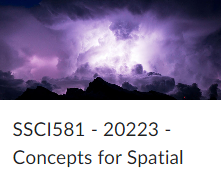SSCI-581-Week13
Automating the Process
ModelBuilder
- Visual programming language to automate geprocessing
- Easily fix and rerun entire processes and tasks with updated data

Three Levels of Automation
- Simple Automation
- Advanced Automation
- Intelligent Automation
Programming
- Why program?
- Can improve productivity by automating routine tasks and eliminating many sources of human error
- Programs are reproducible
- Programs can run 24/7
- Programming can be fun
- Easy idea: Tell computer what your want it to do
- Difficult to execute: Hard to translate your thinking to code
- Frustrations may abound, but remember the goal is to make things easier and it can be fun
The Modeling Process
10 Steps to Develop and Evaluate a Model

Model Simplicity is Key
Incorporating Geographic Information Into Spatial Models
- Balance need to incorporate more data with complexity of model
- Ability to extract useful information from a dataset
- Ability to interpolate useful data from an incomplete dataset through various methods
- Choices of scale
- Need to process data to get to appropriate scale (spatial resolution, spatial scale/study area, temporal resolution) to incorporate into model
Uncertainty Propagation
- Intrinsic Uncertainty - primary data
- Inherited Uncertainty - secondary data
- Operational Uncertainty - related to software and hardware in processing
- Uncertainty in Use - perceptions and misinterpretations
- Ways in which to measure uncertainty; ways to evaluate and control for some of these
Considerations for Model Development
- Importance of transparency of how you have used a model; model parameters, data, calculations, and output
- Transparency increases replicability and “trust” in models and model results
- Documentation and being able to explain all aspects of a model - type, inputs, assumptions, uncertainty, error
- iTERATIVE PROCESS
- Balance between accessibility and expertise
All articles in this blog are licensed under CC BY-NC-SA 4.0 unless stating additionally.
Comment


